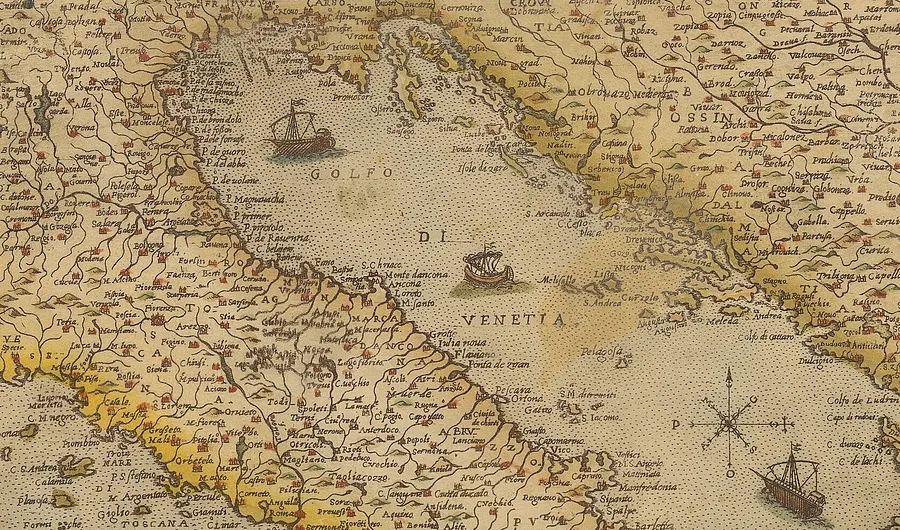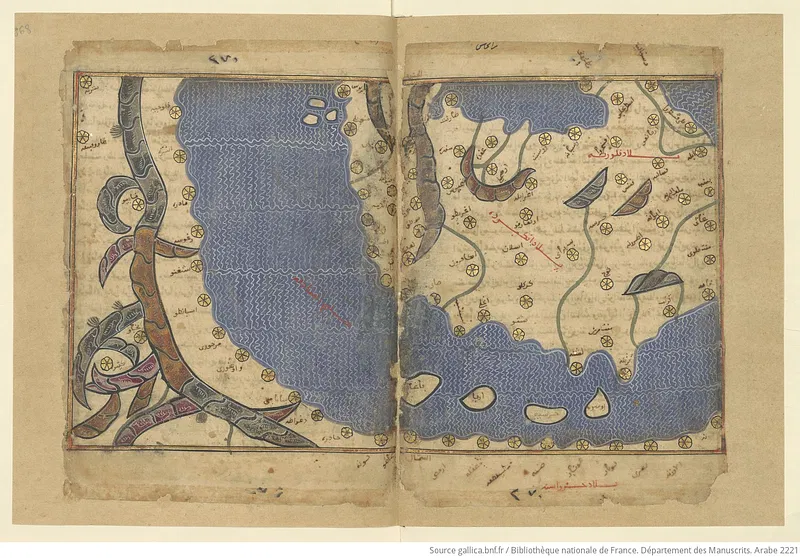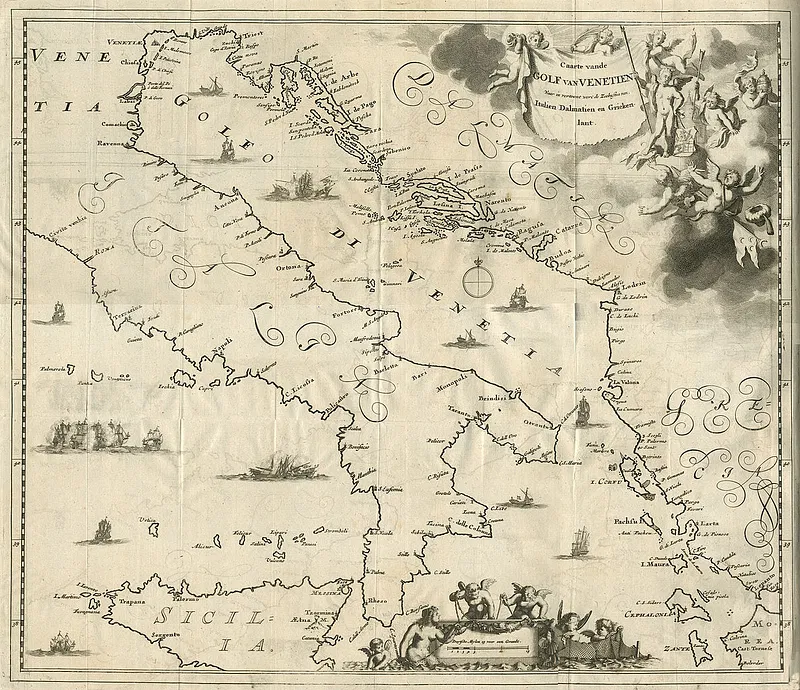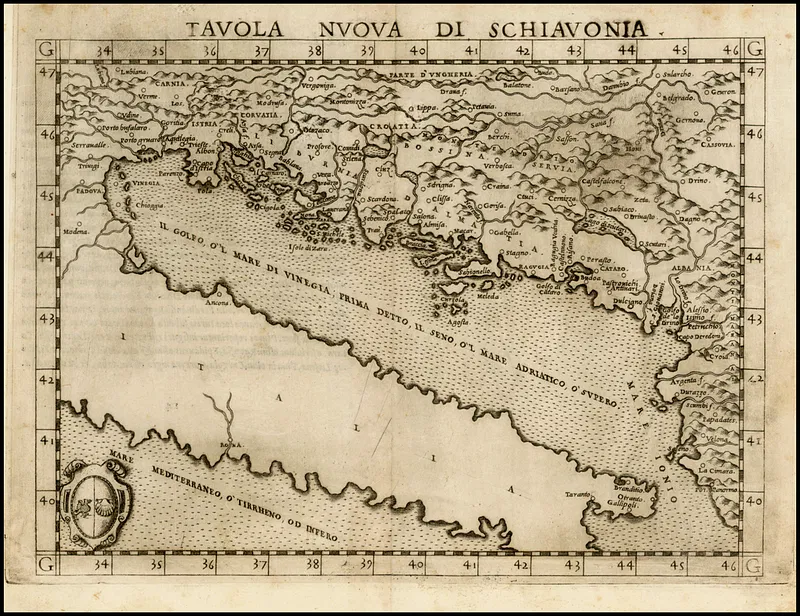
Atlas factice des possessions de Venise et de l’Archipel, created in 1571.
From Medivalists
For centuries a debate was taking place among Europe’s mapmakers: should the Adriatic Sea be called the Gulf of Venice?
A new article in the Journal of Historical Geography explores this issue, examining 100 maps and nautical charts that were created between the 13th and 19th centuries.
They find that mapmakers were wrestling with whether or not to call the body of water separating Italy from the Balkans the Adriatic Sea or the Gulf of Venice.
And like some of the maritime naming disputes today, geopolitics was playing a role.
The name Adriatic Sea goes as far back as the 6th century BC and comes from the ancient Greeks, who named it after Adria, a port at the mouth of the Po River.
There were a couple of other names used, namely the Sea of Cronus and the Gulf of Rhea, but the Adriatic Sea predominated into the Middle Ages.
Around the year 1000, the Republic of Venice began to expand its power significantly, taking control of lands along the east coast of the Adriatic.
For the next several hundred years the Venetians became a maritime empire, extending as far as Crete and Cyprus.
Venetians were understandably proud of their Republic – in the words of one 16th-century writer, they saw their domain as “the work of immortal gods rather than of men; it is for this reason in particular that they think the city of Venice is superior to all others, whether in our time or even before.”
As the Venetians extended their political rule, as well as cultural and economic power, across the Adriatic, they began seeing that Sea as their particular zone of influence.
It was also during this period that a new name emerged for the Adriatic Sea: the Gulf of Venice (in Italian Golfo di Venezia).
The article’s authors note:
Geographical names are carriers of messages about the objects to which they refer – whose they are or whose they should be – that can influence how they are perceived.
Geographical names shape social space by labelling places and related ideas and images.
The first use of this name comes in the works of Abū’Abdullāh Muhammad al-Idrīsī, a cartographer working for King Roger II of Sicily in the 12th century.
A copy of his work, Nuzhat al-mushtaq fi’khtiraq al–afaq (‘The Book of Pleasant Journeys to Far–off Lands’), produced between 1250 and 1325 includes a map showing the southern part of the Adriatic.
Al-Idrīsī calls it in Arabic Sea/Gulf of Venice.
A new article in the Journal of Historical Geography explores this issue, examining 100 maps and nautical charts that were created between the 13th and 19th centuries.
They find that mapmakers were wrestling with whether or not to call the body of water separating Italy from the Balkans the Adriatic Sea or the Gulf of Venice.
And like some of the maritime naming disputes today, geopolitics was playing a role.
The name Adriatic Sea goes as far back as the 6th century BC and comes from the ancient Greeks, who named it after Adria, a port at the mouth of the Po River.
There were a couple of other names used, namely the Sea of Cronus and the Gulf of Rhea, but the Adriatic Sea predominated into the Middle Ages.
Around the year 1000, the Republic of Venice began to expand its power significantly, taking control of lands along the east coast of the Adriatic.
For the next several hundred years the Venetians became a maritime empire, extending as far as Crete and Cyprus.
Venetians were understandably proud of their Republic – in the words of one 16th-century writer, they saw their domain as “the work of immortal gods rather than of men; it is for this reason in particular that they think the city of Venice is superior to all others, whether in our time or even before.”
As the Venetians extended their political rule, as well as cultural and economic power, across the Adriatic, they began seeing that Sea as their particular zone of influence.
It was also during this period that a new name emerged for the Adriatic Sea: the Gulf of Venice (in Italian Golfo di Venezia).
The article’s authors note:
Geographical names are carriers of messages about the objects to which they refer – whose they are or whose they should be – that can influence how they are perceived.
Geographical names shape social space by labelling places and related ideas and images.
The first use of this name comes in the works of Abū’Abdullāh Muhammad al-Idrīsī, a cartographer working for King Roger II of Sicily in the 12th century.
A copy of his work, Nuzhat al-mushtaq fi’khtiraq al–afaq (‘The Book of Pleasant Journeys to Far–off Lands’), produced between 1250 and 1325 includes a map showing the southern part of the Adriatic.
Al-Idrīsī calls it in Arabic Sea/Gulf of Venice.
The authors of the article looked at 100 maps and nautical charts produced between the 13th and 19th centuries.
Among them, 29 refer the the waters as the Gulf of Venice, 28 as the Adriatic Sea, and 17 as both the Gulf of Venice and the Adriatic Sea.
A further 19 have no name, while 2 of them get the wrong names – in one case it was called the Tyrrhenian Sea, which lies on the other side of Italy, while another had an even more egregious mistake, naming it the Red Sea.
The use of the term Gulf of Venice would reach its height during the 17th and 18th centuries, which included maps made both in Venice and elsewhere in Europe.
The authors note that “the Venetian message was successfully transmitted and effectively disseminated in Europe, at least at the level of linguistic communication in and across space: the name Golfo di Venezia began to be used in other European languages, becoming in fact a widespread exonym.”
However, this would all change with the downfall of the Republic of Venice.
In 1797 it was conquered by Napoleon and subsequently lost many of its possessions in the Adriatic to other European powers.
After this:
The centuries-old use of the name Golfo di Venezia on maps and nautical charts could not disappear ‘overnight’, so on some geographical maps and nautical charts restoration was gradual, with the Venetian name being retained for some years after the fall of Venice, whether written alone or in conjunction with the name ‘Adriatic Sea’.
The last known map with the Venetian name of the Adriatic Sea was made by the Spanish cartographers G. Massa, T. González and M. C. Maré (1824).
 The debate over the name Adriatic Sea has been settled (at least for now), but it is a reminder of how countries often want particular names for bodies of land or water that show connections with their states.
The debate over the name Adriatic Sea has been settled (at least for now), but it is a reminder of how countries often want particular names for bodies of land or water that show connections with their states.This can still be seen in a couple of current disputes about maritime names: the Sea of Japan and the Persian Gulf.
The article, “Geographical names of the Adriatic Sea on medieval and early-modern maps and nautical charts,” by Josip Faričić, Orietta Selva and Dragan Umek, appears in Journal of Historical Geography.
Click here to read it.
A map by Girolamo Ruscelli from 1561.
Wikimedia Commons
Wikimedia Commons



No comments:
Post a Comment